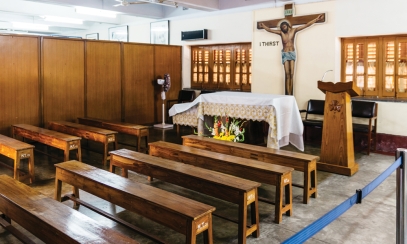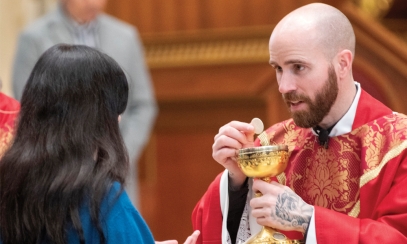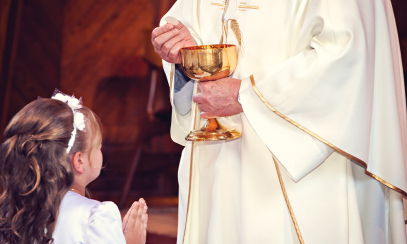
Why bread and wine?
“What are the reasons bread and wine are used in the Eucharist?”
“What are the reasons bread and wine are used in the Eucharist?”
Answer: The answer to this question is worthy of an entire book, but one essential reason is that the Eucharist is, in part, Christ’s fulfillment of the Jewish Passover meal – a sacred meal which involves consuming unleavened bread and four cups of wine. Part of Jesus’ fulfillment of the Old Testament is his fulfillment and transformation of the Passover meal incorporating bread and wine, the very elements required by the Church for a valid Eucharist. The Eucharist also nourishes and enlivens us spiritually, just as bread and wine do at the physical level.
Answer: The answer to this question is worthy of an entire book, but one essential reason is that the Eucharist is, in part, Christ’s fulfillment of the Jewish Passover meal – a sacred meal which involves consuming unleavened bread and four cups of wine. Part of Jesus’ fulfillment of the Old Testament is his fulfillment and transformation of the Passover meal incorporating bread and wine, the very elements required by the Church for a valid Eucharist. The Eucharist also nourishes and enlivens us spiritually, just as bread and wine do at the physical level.
The Eucharist is not a mere symbol. Both the Catholic Church and the Orthodox Church teach that the Eucharist is truly the Body and Blood of the Risen Christ. At the same time, numerous saints from the early Church to modern times have seen great symbolic significance in what is called “the matter” of the Eucharist – that is, the bread and wine which are consecrated by a bishop or priest.
St. Paul saw in the material elements of bread and wine a sign of the unity of Christians that Christ desires: “The cup of blessing that we bless, is it not a participation in the blood of Christ? The bread that we break, is it not a participation in the body of Christ? Because the loaf of bread is one, we, though many, are one body, for we all partake of the one loaf.” (1 Cor 10:16-17)
St. Ignatius, the first Bishop of Antioch, saw great personal significance in the bread used at Mass. As he was being taken to Rome to die as a martyr for Christ around 110 A.D., he wrote in his Epistle to the Romans: “I am the wheat of God, and let me be ground by the teeth of the wild beasts, that I may be found the pure bread of Christ.”
Ignatius’ martyrdom follows the pattern of Christ himself – whose celebration of the first Eucharistic sacrifice at the Last Supper foreshadowed his self-giving offering on the Cross the very next day. As Jesus taught just days before his Passion, “The hour has come for the Son of Man to be glorified. Amen, amen, I say to you, unless a grain of wheat falls to the ground and dies, it remains just a grain of wheat; but if it dies, it produces much fruit.” (Jn 12:23)
On a practical level, using familiar items like bread and wine for the Eucharist makes this sacrament easily accessible for most of the faithful. Since Jesus is God, he also knew that for a weekday Mass on a snowy morning in Michigan, bread and wine would be more readily available than roasted lamb or quail – two other foods with Old Testament significance.
The element of wine used in the sacrament of the Eucharist has been traditionally considered a symbol of joy and celebration. We see this in Jesus’ first miracle – when he changed water into wine at the wedding feast in Cana (see Jn 2:1-12). Even though Jesus’ public ministry would culminate in his crucifixion during which he was ground up like wheat as an offering for all sinners, he insisted that while he was among his disciples, they should celebrate as if at a wedding. When questioned why his followers were not fasting, Jesus replied, “Can the wedding guests fast while the bridegroom is with them? As long as they have the bridegroom with them they cannot fast.” (Mk 2:18-19)
Once Christ rose from the dead, Christianity became at its core a religion of celebration – rejoicing that through his death, Christ has conquered death! All of the baptized are called to share in this Easter joy, which is truly the new wine and fullness of life promised by the Lord!



